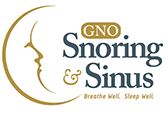Surgical Treatment of Mild OSA
Clinical History: 24 year old female with a history of Mild OSA. CPAP was prescribed for treatment at a pressure of 10 cm H20, but the patient found CPAP therapy difficult to tolerate. Furthermore, given her young age she was interested in alternative options aside from CPAP therapy. The patient’s Body Mass Index was 43, which is consistent with obesity. Seeking further treatment options, the patient presented to GNO Snoring and Sinus.
Physical Exam: A full airway examination in the office revealed significant blockage at the nasal airway via a deviated nasal septum and large inferior turbinates. The patient had an excessively long soft palate and very large tonsils as well, in addition to a large base of tongue causing airway obstruction while sleeping.
Treatment: The patient underwent a surgical procedure consisting of a Septoplasty, Inferior Turbinate Reduction, Uvulo-palato-pharyngoplasty, and Base of Tongue Reduction. This combination of procedures was designed to correct the obstructions created by the deviated nasal septum, large inferior turbinates, obstructing tonsils and soft palate, and large base of tongue.
Results:
Pre-op Sleep Study (4/2015)
Apnea Hypopnea Index (AHI): 11.3 (Mild OSA)
BMI: 43 (Obese)
Surgery (1/2016): Septoplasty, Inferior Turbinate Reduction, Uvulo-palato-pharyngoplasty, and Base of Tongue Reduction
Post-op Sleep Study (2/2016)
Apnea Hypopnea Index(AHI): 3.5 (Normal)
BMI: 43
Summary: Following the surgical procedure, the patient noted an improved ability to breathe both day and night. Furthermore, post surgical sleep study results revealed a total cure in her Sleep Apnea. Given the subjective improvement in breathing and energy as well as the total cure of her sleep apnea – CPAP therapy was no longer required in this individual.
FootNote: This patient represents a growing subset of younger patients we see at GNO Snoring and Sinus – Patients who are diagnosed with Obstructive Sleep Apnea and prescribed CPAP therapy – yet they have correctable anatomic structures that may significantly improve their ability to breathe without CPAP. A full airway assessment should be performed in all patients with sleep apnea prior to initiating CPAP therapy, but most importantly in this population – given their higher cure rate.
